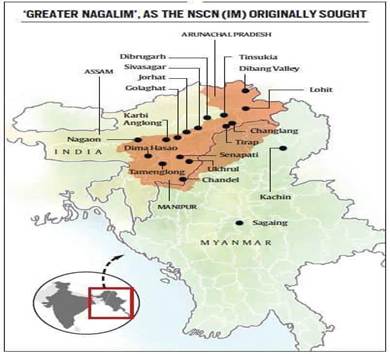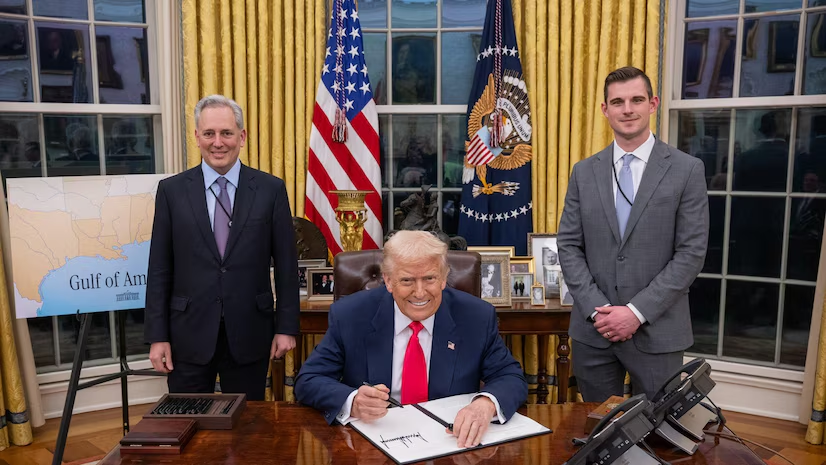- Courses
- GS Full Course 1 Year
- GS Full Course 2 Year
- GS Full Course 3 Year
- GS Full Course Till Selection
- CSAT
- 5 LAYERED ARJUNA Mentorship
- Public Administration Optional
- Online Program
- GS Recorded Course
- NCERT Batch
- Polity Module Course
- Geography Module Course
- Economy Module Course
- AMAC Module Course
- Modern India, Post Independence & World History Module Course
- Environment Module Course
- Governance Module Course
- Science & Tech. Module Course
- International Relations and Internal Security Module Course
- Disaster Management Module Course
- Ethics Module Course
- Essay Module Course
- Current Affairs Module Course
- ABOUT US
- OUR TOPPERS
- TEST SERIES
- FREE STUDY MATERIAL
- VIDEOS
- CONTACT US
Naga Peace Process and the 2015 Framework Agreement
Naga Peace Process and the 2015 Framework Agreement

The National Socialist Council of Nagalim (Isak-Muivah faction), or NSCN (I-M), recently reiterated that its 2015 Framework Agreement with the Indian government should not be equated with the 2017 Agreed Position signed with a conglomerate of rival Naga groups under the Working Committee of the Naga National Political Groups (NNPGs).
Background of the Naga Peace Process
- The Naga insurgency is one of India’s oldest internal security challenges.
- Multiple peace talks have been held since the 1997 ceasefire between the Government of India and NSCN (I-M).
- Two major developments:
- Framework Agreement with NSCN (I-M): August 2015
- Agreed Position with NNPGs: November 2017
2015 Framework Agreement: Key Highlights
The Framework Agreement (FA), signed in August 2015, aimed to pave the way for a comprehensive peace settlement to end the protracted insurgency in Nagaland.
Key Features of the Agreement:
- Recognition of Naga Identity: The Indian government acknowledged the “unique history, culture, and position” of the Nagas.
- Shared Sovereignty: The agreement introduced the concept of shared sovereignty, suggesting a special political and administrative status for Nagas within the Indian Union.
- Peaceful Resolution through Dialogue: The agreement was intended to be the foundation for further negotiations, leading to a final accord.
- Autonomous Governance: As interpreted by NSCN (I-M), the agreement allows for special autonomous arrangements with enhanced legislative, executive, and financial powers for Naga regions.
- No Immediate Territorial Change: Although NSCN (I-M) seeks integration of all Naga-inhabited areas into a unified “Nagalim” (including parts of Arunachal Pradesh, Assam, and Manipur), the agreement does not commit to redrawing existing state boundaries.

Contentious Issues in the Peace Process
Despite the initial optimism, several issues have impeded the final settlement:
1. Demand for Separate Flag and Constitution: NSCN (I-M) insists that the FA included provisions for a distinct Naga flag and constitution, a demand that the Government of India has consistently refused.
2. Ambiguity in Language: The vague wording in the FA has led to contrasting interpretations.
-
- NSCN (I-M) interprets "sharing sovereign power" as acknowledgment of separate sovereignty.
- The Indian government disagrees with this interpretation.
3. Impact of Article 370 Abrogation (2019): The revocation of Article 370 (which granted Jammu & Kashmir a separate constitution and flag) hardened the government’s stance, making it politically difficult to accept NSCN (I-M)’s demands.
4. Poor Drafting of the Agreement: The lack of clarity and specificity in the agreement has complicated negotiations and prolonged the deadlock.
5. Internal Divisions Among Naga Groups
- During R.N. Ravi’s tenure as interlocutor, smaller groups like the NNPGs were brought into the dialogue process.
- While this move aimed at broadening negotiations, NSCN (I-M) perceived it as an attempt to divide the Nagas, thereby stalling progress.
6. No Clear Timeframe for Final Accord: Despite reinitiated talks, lack of clarity over the final roadmap, especially regarding the flag and constitution, has stalled progress.
7. Lack of Transparency: The full text of the Framework Agreement has never been made public, leading to confusion and multiple interpretations.
Current Status of the Peace Process
- Stalemate Since 2019: Negotiations have remained stuck, primarily due to the unresolved flag and constitution issues.
- NSCN (I-M)’s Stand: The group demands that the original spirit of the 2015 agreement be honoured.
- No Final Settlement Yet: Despite over two decades of dialogue, a comprehensive peace accord is still pending.
- Absence of Full-Time Interlocutor: Since 2021, there has been no full-time appointed interlocutor, further weakening the negotiation process.
Way Forward: Recommendations for a Sustainable Peace Accord
1. Inclusion of All Factions: The Government must engage all stakeholders, including NSCN (I-M) and NNPGs, to ensure inclusivity and consensus in the final settlement.
2. Political & Administrative Autonomy
- Consider establishing a bicameral assembly for Nagaland, with nominated members from various tribes.
- Grant greater legislative and financial autonomy to the Naga Assembly.
3. Autonomous Councils in Neighboring States: Create autonomous councils for Naga-dominated areas in Arunachal Pradesh, Assam, and Manipur, with powers similar to those under the Sixth Schedule of the Constitution.
4. Integration and Rehabilitation of Naga Cadres
- Absorb NSCN (I-M) cadres into local armed forces or paramilitary units.
- Provide a structured rehabilitation package to mainstream former militants and prevent the resurgence of insurgency.
5. Cultural and Symbolic Recognition: Promote Naga identity through cultural institutions, local governance models, and linguistic rights.
6. Trust-building Measures
- Appoint a full-time interlocutor to actively pursue negotiations.
- Initiate confidence-building measures such as:
- Greater economic investments
- Infrastructure development
- Cultural exchanges
7. Clear Roadmap with Deadlines: Define a transparent, time-bound roadmap for reaching the final agreement to ensure mutual commitment and accountability.
Constitutional Safeguards for Nagaland: Article 371A
In the backdrop of the Naga peace process, it is essential to understand the special constitutional provisions already in place for Nagaland. These provisions are enshrined in Article 371A of the Indian Constitution, providing autonomy and protection to preserve the unique identity and customs of the Naga people.
Key Provisions of Article 371A: Special Constitutional Status of Nagaland
1. Parliamentary Acts Not Automatically Applicable
- As per Article 371A, Acts of Parliament shall not apply to Nagaland in respect of the following matters unless the Nagaland State Legislative Assembly specifically decides to adopt them:
- Religious or social practices of the Nagas
- Naga customary law and procedure
- Administration of civil and criminal justice involving decisions according to Naga customary law
- Ownership and transfer of land and its resources
➡ This provision ensures that Naga cultural, legal, and land practices are preserved and not overridden by national legislation.
2. Special Responsibility of the Governor for Law and Order
- The Governor of Nagaland holds a special responsibility for maintaining law and order, particularly during periods of internal disturbances caused by hostile elements.
- In exercising this responsibility, the Governor:
- Must consult the Council of Ministers
- Exercises individual judgment, and the Governor’s decision is final
- This special power ceases only when the President of India directs its withdrawal.
➡ This unique arrangement reflects the Centre’s concern for maintaining peace in a sensitive region while ensuring administrative oversight.
3. Financial Responsibility of the Governor
- The Governor must ensure that funds provided by the Central Government for any specific purpose are included only under the relevant demand for grants in the State Legislative Assembly.
- These funds must not be diverted or included under any unrelated demand.
➡ This clause is aimed at ensuring transparency and targeted utilization of central funds, especially for development and welfare programs.
4. Special Administrative Arrangement for Tuensang District
- Article 371A also mandated the creation of a Regional Council for the Tuensang district, with 35 members.
- The Governor has the authority to frame rules regarding:
- Composition and structure of the Council
- Manner of selection and qualifications of members
- Their term, salaries, and allowances
- Procedure and conduct of business
- Appointment of officers and staff, including their service conditions
- Any other matter related to the effective functioning of the Council
➡ This provision was initially designed to give special administrative care to Tuensang, one of the most backward and sensitive regions of Nagaland.
Significance in the Context of Naga Peace Process
- Article 371A already provides a high degree of autonomy to Nagaland in cultural, administrative, and legal matters, showcasing India's constitutional flexibility in accommodating ethnic diversity.
- However, NSCN (I-M) argues that these provisions are not sufficient and demand further autonomy, including a separate flag and constitution.
- The government, on the other hand, views Article 371A as a robust constitutional safeguard, making additional concessions politically difficult, especially post-Article 370 abrogation.
|
Also Read |
|
UPSC Foundation Course |
|
| UPSC Monthly Magazine | CSAT Foundation Course |




